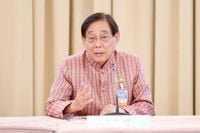Thailand’s Deputy Prime Minister and Minister of Finance, Pichai Chunhavajira, has firmly dismissed recent reports claiming that Thailand and the United States have reached a finalized agreement on an 18% import tariff rate. In a series of clarifications issued on June 26, 2025, Pichai emphasized that such claims are inaccurate and that the negotiations remain ongoing without any official conclusion.
The 18% figure that has been circulating in media and social platforms is not an official tariff rate but rather an estimated number used by the Bank of Thailand (BOT) and economists as a hypothetical baseline to simulate potential economic impacts. Pichai made these points clear through a short video posted on social media and further detailed statements on his personal Facebook page.
“The news suggesting that Thailand has concluded negotiations with the United States on an 18% tariff rate is not true,” Pichai stated. “We have not reached any conclusion yet. The 18% figure is likely a forecast or assumption used solely for economic modeling.”
These remarks came in response to widespread speculation following Thailand’s submission of detailed proposals to the U.S. Trade Representative (USTR) on June 24, 2025. The proposals pertain to reciprocal tariffs, a contentious issue that has been part of broader efforts to address the trade imbalance between the two nations.
Under the administration of former President Donald Trump, the United States had imposed a 36% reciprocal tariff on Thai goods as a countermeasure. This tariff has been a significant point of friction in bilateral trade relations. A 90-day extension of the enforcement deadline was granted by the U.S., with the current expiration set for July 9, 2025. However, it remains unclear whether this extension will be prolonged further.
Pichai noted that the ongoing negotiations with the USTR are still in the phase of detailed discussions, with no country having finalized agreements on this matter at present. He also highlighted that while Thailand has submitted its proposals, the U.S. is still considering whether to extend the negotiation timeline beyond the current 90-day window.
“We are still in the negotiation phase,” Pichai reiterated. “The deadline for further discussions is not yet determined, and no country has genuinely closed these negotiations at this time.”
This negotiation process is part of a larger strategy aimed at resolving the trade deficit and establishing a more balanced trade relationship between Thailand and the United States. The reciprocal tariffs have been a critical obstacle, and both sides appear committed to finding a workable solution.
Despite the speculation and rumors, Pichai’s clarifications serve as a reminder of the complexity and ongoing nature of international trade negotiations. The use of estimated figures like the 18% tariff rate for economic simulations is a standard practice among economists and financial institutions to forecast potential impacts, but these numbers should not be misconstrued as finalized policy decisions.
Thailand’s economic stakeholders and the public are advised to await official announcements from government representatives and trade negotiators before drawing conclusions about the outcome of these talks. The deputy prime minister’s communications underscore the importance of accuracy and caution in reporting sensitive economic matters that could influence markets and public perception.
As the July 9 deadline approaches, attention will focus on whether the United States opts to extend the negotiation period and how both nations might advance toward a resolution. For now, the trade talks remain an active and evolving process, with no definitive agreements reached.
In the meantime, Pichai’s public statements aim to dispel misinformation and provide transparent updates on the status of the discussions. His insistence that the 18% tariff figure is merely an assumption used for modeling purposes helps clarify the distinction between speculative estimates and actual policy outcomes.
With global trade dynamics continually shifting, the resolution of tariff disputes like this one will be crucial in shaping Thailand’s economic future and its bilateral relations with the United States. Both countries appear to recognize the stakes involved and the need for careful negotiation to achieve mutually beneficial terms.
For now, the message from Thailand’s finance minister is clear: the talks are ongoing, no deal has been finalized, and the 18% tariff figure is not set in stone. Stakeholders will be watching closely as the situation develops in the coming weeks.





